It looks like you're using an Ad Blocker.
Please white-list or disable AboveTopSecret.com in your ad-blocking tool.
Thank you.
Some features of ATS will be disabled while you continue to use an ad-blocker.
share:
Hello all,
Examining Nasa's latest Mars rover images, I found what looks like possible Crinoid and Prasopora type fossils that have been exposed by wind.
This image was cut from an area called Yellowknife Bay. I didn't find anymore of these "fossils" anywhere else on the photo.
The possibility of these being fossils are small, but I find it odd that they are found in such a small area. Ancient shoreline?
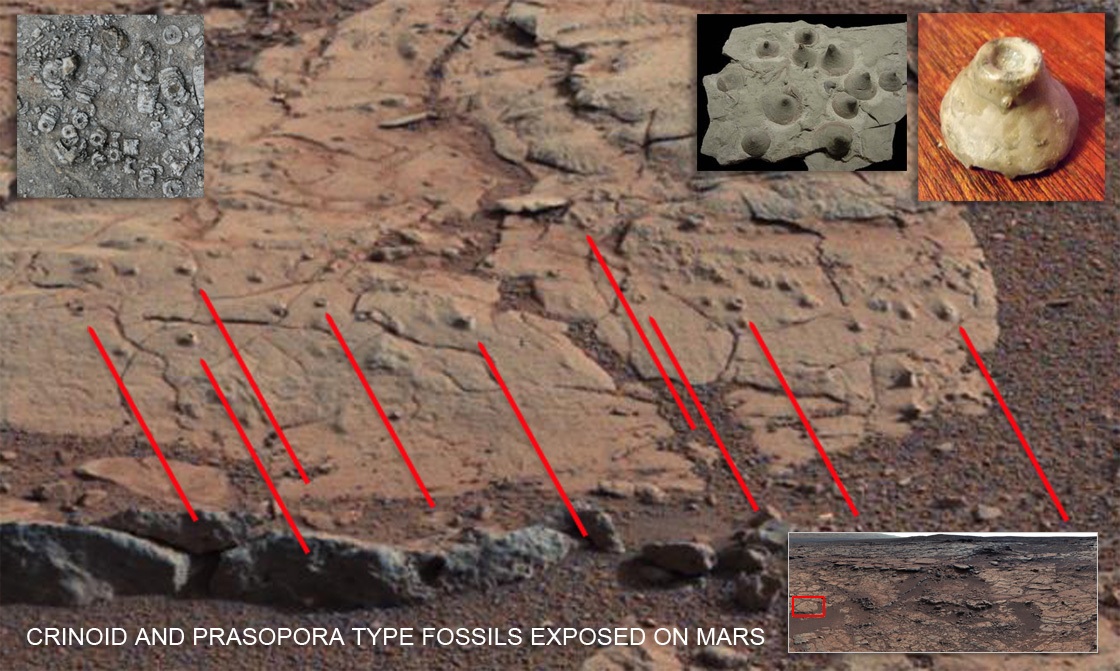
Nasa's original image here
Examining Nasa's latest Mars rover images, I found what looks like possible Crinoid and Prasopora type fossils that have been exposed by wind.
This image was cut from an area called Yellowknife Bay. I didn't find anymore of these "fossils" anywhere else on the photo.
The possibility of these being fossils are small, but I find it odd that they are found in such a small area. Ancient shoreline?

Nasa's original image here
reply to post by super70
After zooming way in on the "thumbnail" photo in the upper left I see, what to me, looks like a Conch shell laying on it's side.
It is at the upper part of the pic above the circular thingys.
The whole picture looks organic and fossil like. But ??? who knows
After zooming way in on the "thumbnail" photo in the upper left I see, what to me, looks like a Conch shell laying on it's side.
It is at the upper part of the pic above the circular thingys.
The whole picture looks organic and fossil like. But ??? who knows
edit on 20-1-2014 by grubblesnert because: spellin'
At least it's not just looking like rocks this time.
I like your theory, would like to know NASA's take on this. Could also be some wents of some sort.
Good find
I like your theory, would like to know NASA's take on this. Could also be some wents of some sort.
Good find
edit on 20-1-2014 by Mianeye because: (no reason given)
Good find s and f. The evidence is mounting for past and present life on mars. No wonder the bookies have drasticly cut the odds of alien life being
discovered.
grubblesnert
reply to post by super70
After zooming way in on the "thumbnail" photo in the upper left I see, what to me, looks like a Conch shell laying on it's side.
It is at the upper part of the pic above the circular thingys.
The whole picture looks organic and fossil like. But ??? who knowsedit on 20-1-2014 by grubblesnert because: spellin'
After paying more attention to the Illustration in the OPs post I just realized that the "thumbnail" pic I was looking at is most likely earth based and put up there for comparison
Please corrected me if I'm not as dumb as I actually feel right now!!
reply to post by super70
Interesting find, super70, perhaps someone with geological expertise could look into this. The image section is from sol 137 and there are larger close-ups available, here go some cropped versions (normal and white-balanced):
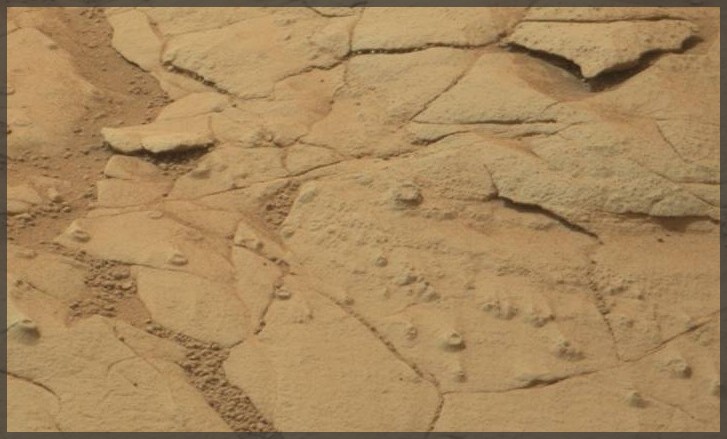
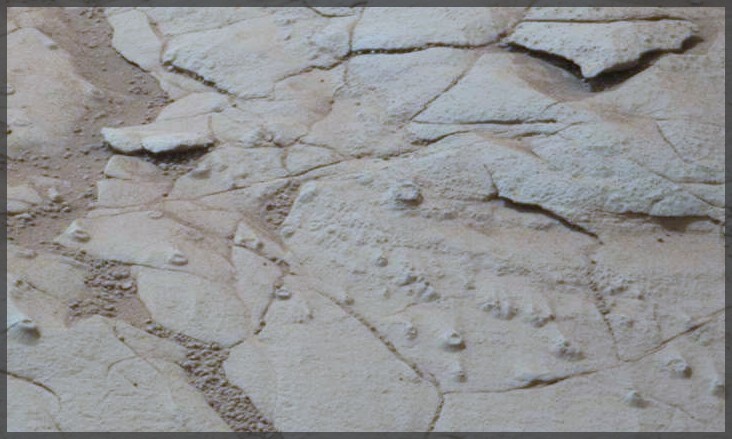
Original Source Image:
mars.jpl.nasa.gov...
Interesting find, super70, perhaps someone with geological expertise could look into this. The image section is from sol 137 and there are larger close-ups available, here go some cropped versions (normal and white-balanced):


Original Source Image:
mars.jpl.nasa.gov...
Looks like fossilized kitchen cabinet knobs to me!
S&F for intriguing insight.. would like to see more comps of mars crinoid/prasoic to earth's tho
S&F for intriguing insight.. would like to see more comps of mars crinoid/prasoic to earth's tho
reply to post by super70
my initial thought was that it could have been some form of stalagmite in years long gone, but then it doesn't explain the circular hole in the middle (as far as I know anyway), interesting post OP S+F
my initial thought was that it could have been some form of stalagmite in years long gone, but then it doesn't explain the circular hole in the middle (as far as I know anyway), interesting post OP S+F
Thanks for sharing. I can see what you're talking about. The raw image from the nasa site is amazing. I have been looking at it for over a hour now.
I don't know why, but everytime I see a picture from Mars I feel like i'm crawdad fishing. I just want to walk around flipping rocks over to see
what underneath. S & F for you though. I'll be back, going to look around in the image a little more.
reply to post by super70
I think what you were getting at (specifically) are the crinoid holdfasts. Here's an image from wikipedia showing an earthly version of these coneshaped features with an opening on top:
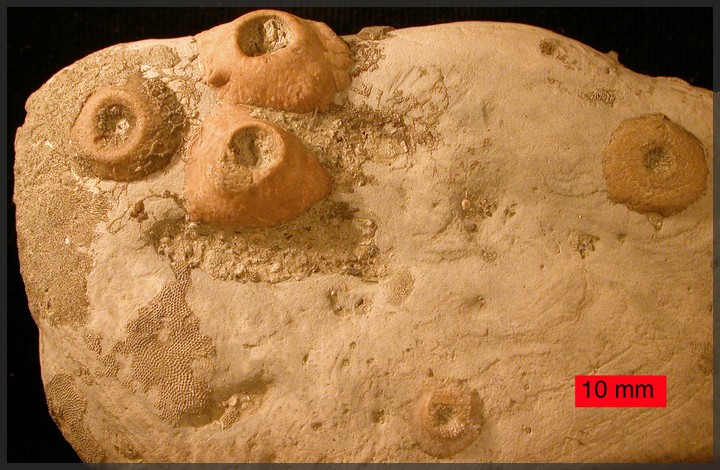 Image Source: Wikipedia, Public Domain
Image Source: Wikipedia, Public Domain
And sol 137 again for comparison:

If this had been imaged by MAHLI in even higher resolution, the first picture should be more or less what we should be seeing (in detail) on the Martian surface, provided that these really are crinoid holdfasts ... but a close resemblance is there IMO!
Original Source Image:
mars.jpl.nasa.gov...
I think what you were getting at (specifically) are the crinoid holdfasts. Here's an image from wikipedia showing an earthly version of these coneshaped features with an opening on top:

And sol 137 again for comparison:

If this had been imaged by MAHLI in even higher resolution, the first picture should be more or less what we should be seeing (in detail) on the Martian surface, provided that these really are crinoid holdfasts ... but a close resemblance is there IMO!
Original Source Image:
mars.jpl.nasa.gov...
edit on 20-1-2014 by jeep3r because:
text
reply to post by jeenyus2008
Wow my thoughts exactly, these images amaze me. Ive spent many sunny afternoons in creek beds looking for crawdads
and fossils too, thought it was just me!
Wow my thoughts exactly, these images amaze me. Ive spent many sunny afternoons in creek beds looking for crawdads
and fossils too, thought it was just me!
edit on 20-1-2014 by super70 because: (no reason given)
Personally I have never wondered if life once existed on Mars. I think the topography of Mars (and your find) completely support that life of some
type once existed. Even scientists think life once existed there.
What I am even more curious about is what happened to the atmosphere of Mars?
What I am even more curious about is what happened to the atmosphere of Mars?
reply to post by super70
What's most interesting to me is how they are all attached to, and elevated from, the rock face. Could this rounding and upraising occur with wind erosion and dust/sand shear?
super70 and Jeep3r have teamed up to present some good data and photographic focus on an interesting phenomena of rock and/or nature.
I think you mean anthills, and that one on the lower left side of jeeps pictures seems like a good example of whatever these are (and there should be a "ah ha" explanation coming soon. I thought of Phage, but haven't "seen" him around ATS lately).
What's most interesting to me is how they are all attached to, and elevated from, the rock face. Could this rounding and upraising occur with wind erosion and dust/sand shear?
super70 and Jeep3r have teamed up to present some good data and photographic focus on an interesting phenomena of rock and/or nature.
Mamatus
Space ants! Nice find OP.
I think you mean anthills, and that one on the lower left side of jeeps pictures seems like a good example of whatever these are (and there should be a "ah ha" explanation coming soon. I thought of Phage, but haven't "seen" him around ATS lately).
edit on 20-1-2014 by Aleister because: (no reason given)
edit on 20-1-2014 by Aleister because: (no reason
given)
edit on 20-1-2014 by Aleister because: (no reason given)
edit on 20-1-2014 by Aleister because: (no reason
given)
edit on 20-1-2014 by Aleister because: (no reason given)
reply to post by Aleister
Possibly. One theory could be this was a shallow shoreline of silt and mud. Gas trickled up through the rock forming small cone shaped bubbling structures. The water evaporated leaving the protrusions exposed which hardened into stone over time.
But I preffer the idea that these are ancient water borne crustacean fossils!
Possibly. One theory could be this was a shallow shoreline of silt and mud. Gas trickled up through the rock forming small cone shaped bubbling structures. The water evaporated leaving the protrusions exposed which hardened into stone over time.
But I preffer the idea that these are ancient water borne crustacean fossils!
super70
reply to post by Aleister
Possibly. One theory could be this was a shallow shoreline of silt and mud. Gas trickled up through the rock forming small cone shaped bubbling structures. The water evaporated leaving the protrusions exposed which hardened into stone over time.
But I preffer the idea that these are ancient water borne crustacean fossils!
Very good explanation, thank you. That would work. Lots of us want things on Mars to be fossils, but like in all good research everything must be analyzed for the "this could have made it" explanations. I put up a thread on a mars skeleton this week and then was told it was all pixel distortion. Fun while it lasts (and those pixels made a very nice skeleton). Your explanation makes sense, and just adds to proving that Gale Lake existed and had a long life.
reply to post by Aleister
While this possible theory could explain the conical shaped crinoid holdfast and prasopora claims, it does not explain the crinoid stem fossils. The fact that they are in close proximaty to the cones (like you might find on a shoreline on earth) makes the case for fossila, rather than tiny mud volcanoes.
While this possible theory could explain the conical shaped crinoid holdfast and prasopora claims, it does not explain the crinoid stem fossils. The fact that they are in close proximaty to the cones (like you might find on a shoreline on earth) makes the case for fossila, rather than tiny mud volcanoes.
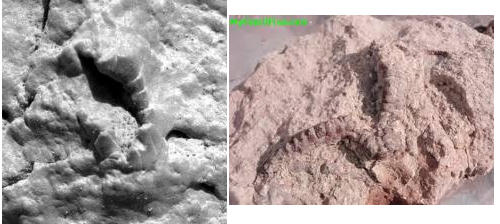
One of these is an identified Earth Crinoid fossil. The other is "apparently" just a rock formation on Mars. Hmmmm
reply to post by yorkshirelad
I know! This was Richard Hoagland's find in the very first crater that the first Mars Rover landed in. And then NASA ground it down with a drill.
Thanks again. This is shaping up to be one of those good "keeper" threads.
I know! This was Richard Hoagland's find in the very first crater that the first Mars Rover landed in. And then NASA ground it down with a drill.
super70
reply to post by Aleister
While this possible theory could explain the conical shaped crinoid holdfast and prasopora claims, it does not explain the crinoid stem fossils. The fact that they are in close proximity to the cones (like you might find on a shoreline on earth) makes the case for fossila, rather than tiny mud volcanoes.
Thanks again. This is shaping up to be one of those good "keeper" threads.
edit on 20-1-2014 by Aleister because: (no reason given)
new topics
-
Gen Flynn's Sister and her cohort blow the whistle on DHS/CBP involvement in child trafficking.
Whistle Blowers and Leaked Documents: 3 hours ago -
Anybody else using Pomodoro time management technique?
General Chit Chat: 6 hours ago -
Bucks County commissioners vote to count illegal ballots in Pennsylvania recount
2024 Elections: 8 hours ago -
Trump sues media outlets -- 10 Billion Dollar lawsuit
US Political Madness: 9 hours ago -
Fired fema employee speaks.
US Political Madness: 9 hours ago -
How long till it starts
US Political Madness: 11 hours ago
top topics
-
Trump sues media outlets -- 10 Billion Dollar lawsuit
US Political Madness: 9 hours ago, 23 flags -
Bucks County commissioners vote to count illegal ballots in Pennsylvania recount
2024 Elections: 8 hours ago, 19 flags -
How long till it starts
US Political Madness: 11 hours ago, 17 flags -
Watching TV
Jokes, Puns, & Pranks: 15 hours ago, 9 flags -
USSS Agent Fired for Having Sex In Michelle Obama's Bathroom
Politicians & People: 12 hours ago, 9 flags -
Fired fema employee speaks.
US Political Madness: 9 hours ago, 9 flags -
Gen Flynn's Sister and her cohort blow the whistle on DHS/CBP involvement in child trafficking.
Whistle Blowers and Leaked Documents: 3 hours ago, 6 flags -
Anybody else using Pomodoro time management technique?
General Chit Chat: 6 hours ago, 3 flags
active topics
-
The Trump effect 6 days after 2024 election
2024 Elections • 141 • : cherokeetroy -
Thanksgiving 2024
Member Art • 19 • : rickymouse -
President-Elect Donald Trump will Meet with Coup-Victim JOE BIDEN on Wed 11.13.2024.
2024 Elections • 35 • : WeMustCare -
Mike Tyson returns 11-15-24
World Sports • 46 • : argentus -
President-Elect DONALD TRUMP's 2nd-Term Administration Takes Shape.
Political Ideology • 202 • : WeMustCare -
TODAY IS A HUGE ELECTION DAY FOR AMERICA - November 5th 2024 - Reports from Around The Nation.
2024 Elections • 749 • : WeMustCare -
The Acronym Game .. Pt.4
General Chit Chat • 960 • : FullHeathen -
Trump picks Gov. Kristi Noem to serve as homeland security secretary
2024 Elections • 44 • : Solvedit -
Trump sues media outlets -- 10 Billion Dollar lawsuit
US Political Madness • 44 • : Lumenari -
USSS Agent Fired for Having Sex In Michelle Obama's Bathroom
Politicians & People • 23 • : schuyler2
